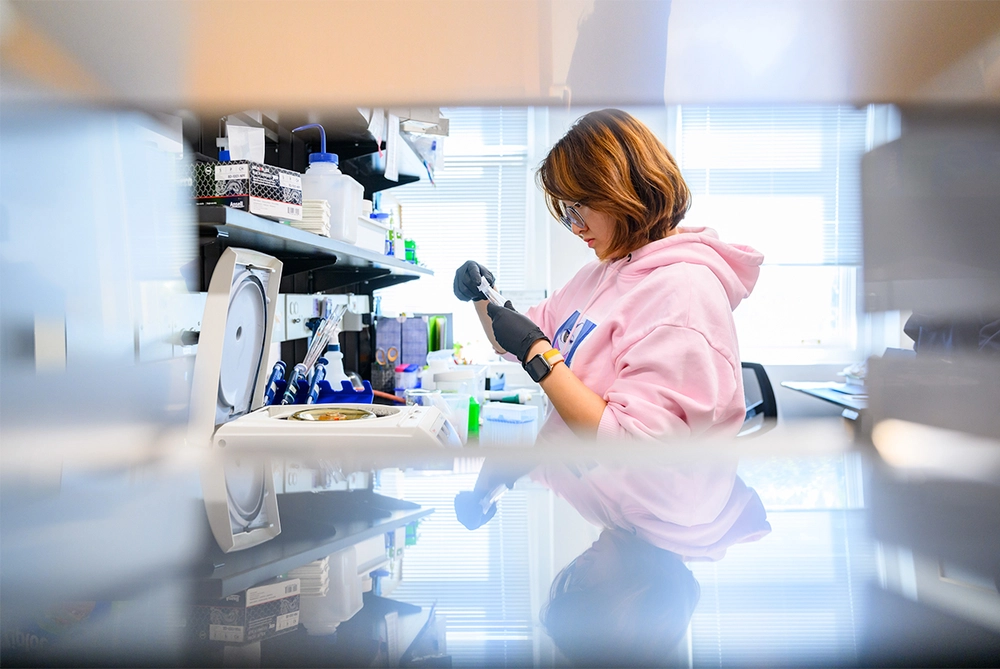
Antibodies—proteins that are produced by our immune system to protect us—are crucial for recognizing and getting rid of unwanted substances, or antigens, in our body. Although their role is universal, antibody structure varies in different animals. In a new study, researchers have analyzed the antibody Immunoglobulin M in rainbow trout to shed light on why these proteins may have evolved over time.
In humans, IgM consists of five repeating units that are held together by a joining chain, resulting in a star shape. Consequently, IgM can bind to multiple antigens at the same time, clearing them quickly. IgM is also unique because it is found in blood and mucosa, which is moist tissue that lines body canals, including the nose, mouth, and intestine.
“Our lab studies the structure and functions of IgM, and we are interested in understanding how it is assembled,” said Beth Stadtmueller, an assistant professor of biochemistry. “We have been looking at fish and mammals because there are considerable differences in how their immune systems have evolved, and we want to understand why they build antibodies differently.”
The first big difference between antibody functions in fish and humans is that the mucosa of fish includes the skin.
“In fish, a large part of their mucosal surface is constantly exposed to their environment. Their antibodies, therefore, have to be able to be structurally stable so that they can stay in the mucosa instead of getting washed away by water, and they are likely to encounter different types of antigens compared to humans,” said Mengfan Lyu, a graduate student in the Stadtmueller lab and the first author of the paper.
Another major difference between fish and human antibodies is that they lack the joining chain, which, in humans, lassos the tail ends of the five individual units together to create a stable star-like antibody. Fish IgM also has just four repeating units instead of five. These differences have led scientists to wonder how a fish creates a stable IgM and how it functions. To better understand the structure of fish IgM, researchers used rainbow trout IgM for their studies.
“So far, most studies have focused on how antibodies bind to antigens or on the structures of antibodies with a single unit because studies of antibodies containing more than one unit, or polymeric antibodies, have been challenging,” Lyu said. “Only in the past several years have researchers had access to high resolution cryogenic electron microscopy to reveal the structures of polymeric antibodies such as IgM.”
In humans, each repeating unit of IgM is a Y-shaped structure with two hands that bind to the antigen and a stalk. In its star-like form, five stalks make up the central core together with the joining chain. Each repeating unit of fish IgM is similar to human IgM and researchers worked with just the stalk of the fish IgM since the full-length IgM was difficult to work with. Using the cryo-EM technique they discovered that at the core of the fish IgM, the individual units fold differently at their tail ends causing them to assemble toward one side, rather than the center of the IgM; this appears to allow them to interact even though they do not have a joining chain.
“As far as we know, this is the first fish antibody structure that has been characterized,” Stadtmueller said. “It is interesting because the joining chain is necessary for the vast majority of IgM assembly in birds and mammals. Lyu’s discovery tells us that the fish IgM assembles in a very different way and has a distinct structure. It is really interesting from an evolution perspective and implies that fish IgM and human IgM can bind antigens and function differently.”
It is unclear why the joining chain is absent in bony fish.
“Clearly fish have evolved a way to make IgM without joining chain; it may be more efficient to assemble IgM this way, it may result in a more stable structure, or it may provide functional advantages particularly since fish encounter different antigens than humans and other components of their immune system are also distinct.” Lyu said, “All of these factors may have led to differences in the structure of IgM.”
The researchers are currently working on building the full-length IgM, which will include fragments that are missing in the present study.
“This study is an example of how structural biology has given us a foundation to ask how antibodies can be functionally different,” Stadtmueller said. “We anticipate that we will be able to use what we have learned to study other polymeric antibodies, like those from birds, and build novel, therapeutic antibodies.”
The study, “The structure of the teleost Immunoglobulin M core provides insights on polymeric antibody evolution, assembly, and function,” was published in Nature Communications and can be found at https://www.nature.com/articles/s41467-023-43240-z. The work was funded by the National Institutes of Health and the University of Illinois Urbana-Champaign.
Photo credit: Biochemistry graduate student Mengfan Lyu, a member of the Stadtmueller lab, studies the structure of the antibody IgM in rainbow trout. Photo by Fred Zwicky, University of Illinois.
